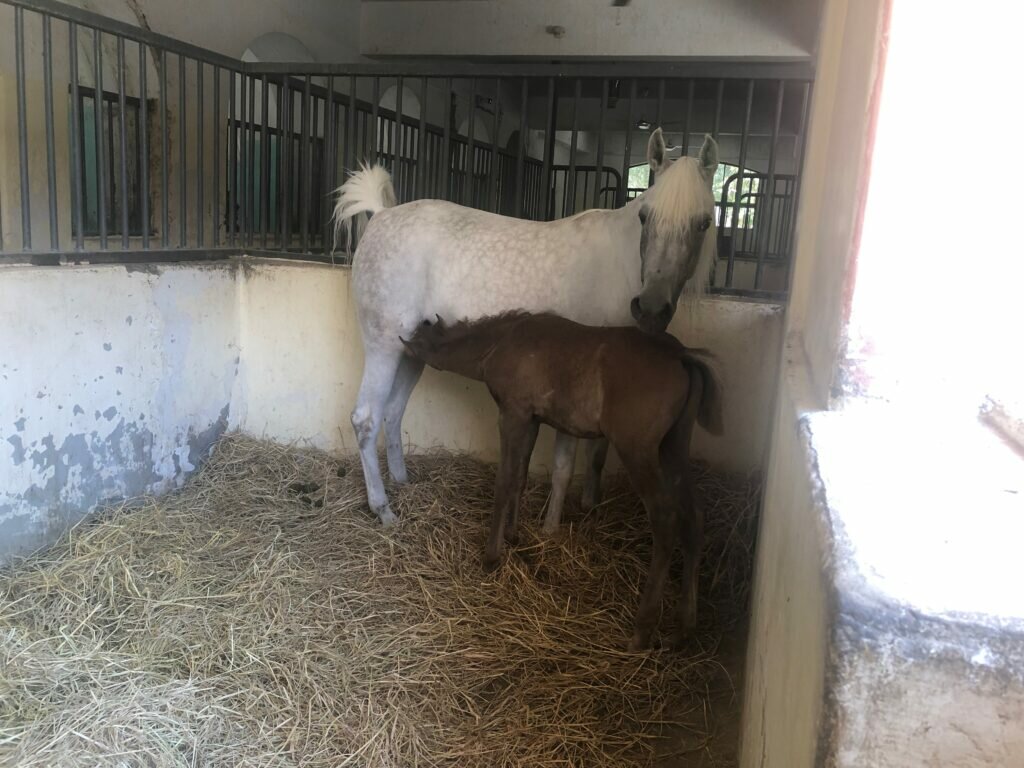The peak of ovulation is in the summer and estrus disappears in the winter, spring and autumn, transient periods, “the disappearance of estrus, measurement of the level of hormones and rectal examination” to diagnose pregnancy. Horses are famous for their “long day” breeding .. The natural season extends from spring to late summer.
The stage of fertility and childbirth in mares includes several stages, beginning with the cycle of estrus and ending with the birth process, as the reproductive activity in horses is seasonal, so the natural breeding season in mares extends from the beginning of spring to the end of summer, and it is in the northern hemisphere from April to September And in the Southern Hemisphere from October to March.
The cycle of eroticism.

Horses are described as “long day” breeding, because the natural reproductive cycle in the mare is activated mainly by the increase in the length of daylight “meaning a long period of light” in the beginning of spring, while at the end of summer and early autumn the period of daylight shortens “a short period of light”, so it occurs. Stimulation of the end of the breeding season.
It is noteworthy that there is a strong relationship between the period of light and the occurrence of ovulation in the mare. Ovulation in the mare reaches its lowest level or disappears during the winter season, while the peak of ovulation usually occurs in the summer and the spring and autumn seasons are considered transient periods, and are characterized by often irregular cycles that differ in both the timing of the cycle and the time of ovulation, and during the breeding season comes the diet mares Citizenship every 21 days, on average, “from 18 to 24 days.”
The cycle of estrus lasts about 5 days “from 3 to 9 days”, and ovulation occurs from “24 to 48 hours” before the end of heat, as the horse goes through a long cycle of estrus during the spring and autumn seasons “from 7 to 10 days”, then during the middle of summer 4 to 5 days.
The discovery of eroticism
One of the most common methods used to detect estrus in mares is the “stirring” method, where the mare advances to the stallion and the external signs of lust appear, and during estrus the mare allows – it may encourage the stallion to advance towards her and stand up and raise her tail and urinate and the clitoris “wink” the clitoris and stands steady in front of the stallion It may lick, bite, or threaten itself. Once the stallion obstructs the movement of the hind legs of the mare’s “knee and shank”, the mare leans more in the pelvis.
These signs may not appear at the beginning of the breeding season and also during the first stage of estrus, but gradually they become apparent with the continuation of the season and towards the time of ovulation, and there are other external stimuli that may occur without noticing the signs of estrus, such as the presence of a foal next to the mare or the presence of a different environment surrounding In it, under these circumstances it is preferable to use the “ruling slave”, which can lead to clear signs of eroticism.
Fertilization
Fertilization occurs in mares in the oviduct and can reach 30 hours after ovulation, and the egg is transferred through the egg canal to the uterus and takes about 6 days. When the egg reaches the uterus and is fertilized, the embryo remains “spherical in shape” not attached to the wall of the uterus and migrates freely in the uterus. All parts of the uterine cavity until the 17th day after ovulation, which is considered an appropriate time for the initial recognition of a mare pregnancy.
Pregnancy diagnosis
Diagnosis of early pregnancy is necessary to be able to try again with these mares, if it is found that they are not pregnant, as well as to detect the presence of twins as soon as possible. Among the methods of diagnosing pregnancy is the disappearance of the behavior of estrus “later”, as this method is simple but not completely reliable and mares may differ in the severity of signs of estrus, especially when using the stallion scout or if there is activity of the yellow body for long periods “.
Diagnosis can also be made by measuring levels of hormones: plasma progesterone, chorionic gonadotrophin stimulating hormone (eCG) / serum gonadotrophin in a pregnant mare (PMSG), placenta estrogens, pregnancy protein measurement, early pregnancy factor (EPF), fertilization factor Early (ECF).
Ultrasound rectal examination: rectal palpation by a veterinarian, nowadays usually accompanied by an ultrasound scanning method (sonar), which is an accurate and useful method in diagnosing pregnancy, experienced veterinary practitioners can detect pregnancy in the mare using a rectal probe. As early as “13 to 16 days” after ovulation, it is also possible to measure the size of the fetus and check its growth rate.
The sonar adds additional advantages, that early in the diagnosis of pregnancy, a “twin pregnancy” can be detected in time to take the necessary measures, and non-pregnant mares can be identified early enough to restore the opportunity to mate again.
Fetal growth and birth.
Childbirth is the process of active expulsion of the fetus and its associated fluid and the placenta membranes, where the average pregnancy for a mare is 11 months (from 310 to 365 days), and many mares have a phenomenon (waxing) and this name occurs due to the accumulation of dry sediment at the end of the mare’s nipples and is considered a sign Good near birth.
When the date of birth approaches, the mare becomes anxious and tense, especially if it begins to enter the first stage of childbirth, and during the first stage of birth, the mare may show signs that resemble colic, such as walking in circles, moving her tail and may bump her belly and then lie down and look around its sides, while once the first stage is over From birth, the mare may notice severe sweating.
Childbirth normally ends within three hours of the end of the second stage, while contractions of the uterine muscles continue at a level similar to that which occurs during the first stage of childbirth, as it usually starts from the uterine horn and goes downward in waves towards the cervix, and at the same time the placental membranes begin in Atrophy, as soon as contractions occur in the blood vessels and are expelled from the inner wall of the uterus.
The expulsion removes the contact between the endocurians and the epithelium of the uterus, pushing the placenta out of the body, and the placenta is expelled by its inner red wall of the anthurion and the soft white outer surface.
The birth process also expels any remaining fluids and helps in the occurrence of the uterine reflux to its “normal size”. The so-called hypomin is expelled during the second stage of childbirth or with the placenta during the third stage, which is a small body with a brownish color to the touch of the skin and present with the allanthenic fluid, which is an accumulation The salts and minerals that occur during pregnancy, and the hypomin contains a high concentration of “calcium, hyposamine, magnesium, nitrogen, phosphorus, and potassium”, and it is usually the first to appear.
On about the 85th day of pregnancy.
It is worth noting that the mare’s first erotic cycle after birth, the “foal estrus” period, usually occurs between “5 to 15 days” after birth.
Special for horse site






